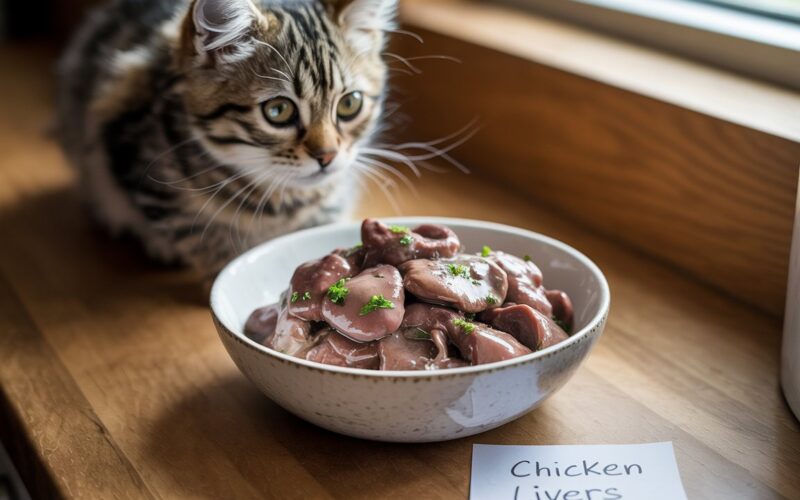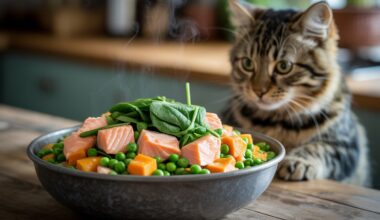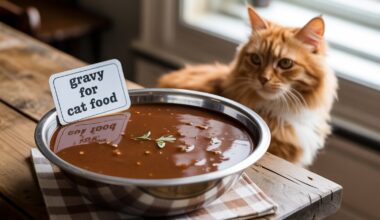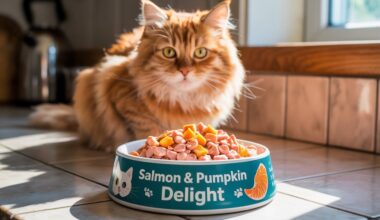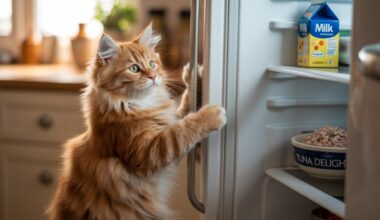Thinking of cooking chicken livers for your cat? Smart move. This tiny organ is packed with nutrients your feline friend craves—but only if it’s done right. In this guide, you’ll learn how to cook chicken liver safely, how much to feed, the risks of overfeeding, and even which organ meats are healthiest for cats. We’ll also answer a few frequently asked questions—like whether liver can harm your cat or which meats to avoid. Let’s make mealtime healthier, tastier, and tail-waggingly good (okay… tail-swishing). Ready?
Why Chicken Liver Is Good for Cats
Some cats are picky. Others? They’ll eat anything.
But here’s the truth: Chicken liver isn’t just a treat. It’s a nutrient powerhouse. Especially for our furry felines.
Rich in Vitamin A, B vitamins, and iron — liver is nature’s multivitamin. Taurine? Yep, it’s in there. And that’s essential for cats. Keeps their hearts pumping, eyes sharp, and brains ticking.
I once had a rescue cat named Luna. Skinny, dull coat, low energy. I started adding cooked liver to her meals twice a week. In a month? Different cat. Full of life. Glowing fur. Like a brand new personality.
That’s the magic.
But — and this is important — moderation is key. We’ll get to that.
Gravy for Cat Food: Homemade, Easy & Healthy Cat Gravy Recipe
Looking to make mealtime more exciting for your cat? Try homemade cat gravy! It’s easy, healthy, and adds moisture and flavor to dry or canned food. With simple ingredients, you can whip up a tasty gravy that your feline will love—no additives or harmful preservatives. Want the full recipe? Check out this Gravy for Cat Food: Homemade, Easy & Healthy Cat Gravy Recipe for step-by-step instructions to keep your cat’s meals delicious and nutritious.

What Can Cats Eat from the Fridge?
Wondering what your cat can safely snack on from your fridge? Not everything in there is good for your furry friend. Cats can enjoy plain cooked meats like chicken, turkey, or beef, some cooked veggies, and small amounts of cheese. But avoid onions, garlic, and anything spicy or salty. For a full list and detailed guide, check out What Can Cats Eat from the Fridge?. It’s a lifesaver when you want to share without the worry.

Is It Safe to Feed Cats Cooked Chicken Liver?
Yes. But also… it depends.
Cooking chicken liver properly makes it safer. Kills bacteria. Gets rid of nasties like salmonella. Especially important if your cat isn’t used to raw feeding.
Some raw feeders swear by uncooked organ meats. That’s okay too — for experienced pet parents with guidance. But most vets? They’ll tell you: cook it.
Just don’t add salt. No garlic. No onions. Not even a sprinkle of seasoning. Those can be toxic to cats.
Boiled, baked, or steamed. That’s your golden trio. We’ll talk methods next.
Bottom line: cooked = safer. Especially for house cats.
How to Cook Chicken Livers for Cats (Step-by-Step)
You don’t need to be a chef. Trust me. If you can boil water, you can do this.
Let’s break it down.
Step 1: Get the Good Stuff
Choose fresh, organic chicken liver. Avoid pale, smelly pieces. They should be deep reddish-brown and firm.
Wash under cold water. Trim away connective tissue or green spots (those are bile — not good for your cat).
Step 2: Boil or Steam (Safest Way)
- Bring water to a light boil.
- Drop in the liver.
- Simmer for 7–10 minutes. No longer. Overcooked liver turns rubbery and loses nutrients.
Optional: Steam instead. Keeps more nutrients in. No need to add anything — just pure liver.
Step 3: Cool & Chop
Let it cool completely. Chop into bite-sized pieces or mash, depending on your cat’s preference.
For kittens, you can blend with a bit of water to make a liver puree.
Tip: Store leftovers in an airtight container. Keeps in the fridge for 3–4 days. Or freeze in cubes for up to 3 months.
Done.
That’s it. Healthy, homemade liver snacks ready to go.
How Much Chicken Liver Can a Cat Have in a Day?
Let’s get this straight — liver is good, but not a daily meal.
Too much = bad news.
Veterinarians recommend liver should be no more than 5–10% of a cat’s total weekly diet. That’s about 1 to 2 teaspoons, 2–3 times a week, for an average adult cat.
Kittens can handle a little more due to rapid growth. But you still want to keep it balanced.
Luna? I gave her a few cubes twice a week. Just enough to boost her meals. Not to replace them.
If you feed liver every day — especially in large amounts — your cat could end up with Vitamin A toxicity. Not fun. We’re talking stiff joints, lethargy, even bone deformities over time.
So yeah. Liver is a supplement. Not a staple.
Side Effects of Feeding Too Much Liver
This part? You don’t want to ignore.
Too much chicken liver can actually harm your cat. It’s super rich in Vitamin A. And while cats need it, there’s a limit.
Over time, excess can build up. That’s called hypervitaminosis A.
Here’s what that might look like:
- Stiff joints
- Bone pain
- Loss of appetite
- Weakness
- Vomiting
Scary, right?
And in extreme cases, cats can develop bony growths on their spine or elbows. Yes — bone growths. From too much of a “good” thing.
Other side effects? Loose stool. Bad breath. Refusing normal food. Your cat might even become a little liver-addicted.
Best way to avoid this? Keep liver as a treat. A supplement. Not the star of the show.
Mix it with other meats. Use it in rotation.
If you’re ever unsure — call the vet. It’s better to check early.
Healthiest Organ Meats for Cats Besides Liver
Liver isn’t the only organ cats can eat.
Let’s explore a few others that offer different nutrients — and keep meals interesting.
1. Chicken Heart
Great source of taurine. Plus, it’s lean. Some cats go wild for it. You can cook it the same way as liver. Just slice it thin so it’s easier to chew.
2. Chicken Gizzards
Chewy, muscular, and rich in zinc and B vitamins. Helps with dental health too — like nature’s toothbrush.
3. Kidney
Packed with selenium and iron. Has a strong smell, though. Not all cats love it. Try mixing small amounts into their food first.
4. Spleen
Less common but highly nutritious. Very high in iron — almost too high. So keep portions tiny.
These organ meats work well in rotation. You don’t want to feed just one type, week after week.
Tip: Use the “Frankenprey” method if you’re feeding raw. That’s 80% muscle meat, 10% bone, 10% organ (half of that being liver).
Or — keep it simple. Boil, chop, mix, feed.
Your cat doesn’t need a Michelin-star meal. Just real food. Balanced.
Where to Buy Fresh Chicken Liver for Cats Near You
This depends on where you live. But I’ll help you think like a local.
Start with your neighborhood butcher. They usually have the freshest supply. Ask if they have chicken liver from hormone-free birds.
Some places even carry organic options — for humans — which are perfectly fine for cats.
If you’re in a larger city, search terms like:
- “Buy chicken liver for pets in [City]”
- “Organic chicken liver near me”
- “Raw pet food supplier [City/Area]”
Farmer’s markets? Goldmine. Especially if you want local, antibiotic-free meat.
Online? You’ve got options:
- Chewy
- Raw Feeding Miami
- Instacart from Whole Foods
- Petco (in some areas)
Wherever you buy, make sure it’s fresh. Smell it. Look at the color. Trust your gut — and your nose.
One last tip? Build a relationship with a local butcher. Tell them it’s for your cat. They’ll usually hook you up with small, fresh batches.
FAQ for how to cook chicken livers for cats
What to Feed Your Cat When You’re Out of Cat Food?
Out of cat food and can’t get to the store? Don’t worry. You can make safe, quick meals with simple kitchen ingredients. In this guide, I’ll share easy cat food substitutes, cheap alternatives, and emergency ideas that won’t harm your cat’s health. Many cat parents get confused—what’s safe, what’s not? We’ll clear that up. But remember, these are just short-term fixes. Always check with your vet before using any homemade food long term. Let’s see Cat Food Substitute Guide.
Can I feed my cat chicken every day?
Well… yes and no. Cats love chicken. It’s lean, easy to digest. But feeding it daily? Not ideal. They need variety. Chicken alone misses out on key nutrients like taurine or omega-3s. My old tabby, Max, once got bored of plain chicken—just walked away. Mix it up. Add liver, heart, or even a bit of fish sometimes. Keeps meals exciting—and balanced.
What is the one meat to never feed a cat?
Processed meat. That’s the villain here. Bacon, salami, sausages? Big no. Full of salt, spices, preservatives—stuff that messes with their tiny bodies. One bite won’t kill ’em, but over time? Trouble. Also, avoid cooked bones. Dangerous. My neighbor fed her cat ham once—ended up with a bloated, puking kitty. Stick to clean, fresh meat. No seasoning, no drama.
How to make a Cat houses for outside diy?
Want to build a DIY outdoor cat house? Great idea! Outdoor shelters protect cats from cold, rain, heat, and predators. They provide stray or weak cats a safe, cozy space. Plus, having a shelter can prevent territorial fights and create a peaceful environment for your pet. If you’re ready to get started, check out this step-by-step guide on how to make a cat houses for outside DIY.


